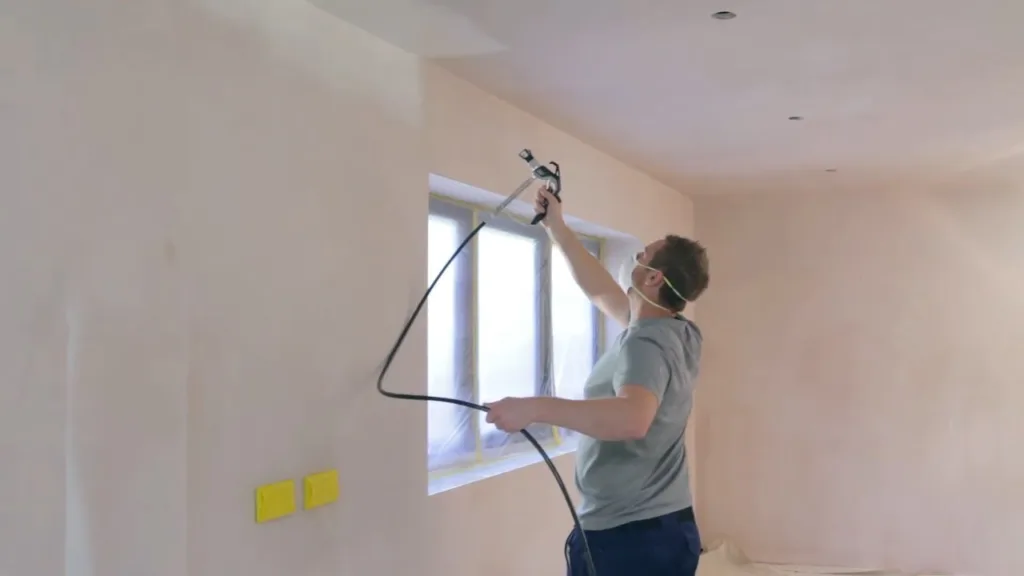If you’re thinking about painting a large area or several surfaces, you may want to consider using an airless paint sprayer. This tool can save you a lot of time and effort compared to traditional brush or roller painting, but it does come with a bit of a learning curve.
One of the most common questions people have when using an airless sprayer is whethr or not they need to thin their paint before using it. The answer is: it depends.
Airless paint sprayers work by pumping paint at high pressure through a small nozzle, which atomizes the paint into tiny droplets and sprays it onto the surface you’re painting. Because of this high pressure, some paints may need to be thinned to a certain consistency in order to work properly with the sprayer.
However, some newer airless sprayer models are designed to work with thicker, un-thinned paint. These sprayers are known as “airless paint sprayers” and they are a great option for people who don’t want to mess with thinning their paint.
If you’re using an older airless sprayer model, or if you’re not sure whether your sprayer can handle un-thinned paint, it’s a good idea to check the manufacturer’s instructions or consult with a professional painter to determine the best approach.
If you do need to thin your paint, there are a few things to keep in mind. First, be sure to use the correct type of thinner for your paint. This information should be available on the paint can or in the manufacturer’s instructions.
Second, be careful not to over-thin your paint. If you thin it too much, it may not provide adequate coverage and you may need to apply multiple coats. On the other hand, if you don’t thin it enough, the paint may clog the sprayer nozzle or produce an uneven finish.
Finally, be sure to wear protective gear such as a respirator mask and goggles when using an airless sprayer. These tools can produce a lot of overspray, which can be harmful if inhaled or if it gets in your eyes.
Airless paint sprayers can be a great tool for painting large areas quickly and efficiently. Whether or not you need to thin your paint depends on the type of sprayer you’re using and the type of paint you’re using. Always consult the manufacturer’s instructions or a professional painter if you’re unsure. And, as always, be sure to wear protective gear when using any type of spray painting equipment.
Should Paint Be Thinned When Using an Airless Sprayer?
When using an airless paint sprayer, it is not always neessary to thin the paint. However, it depends on the manufacturer’s recommendations and the type of paint being used. Some thicker paints like latex may need to be thinned to achieve proper consistency for spraying. On the other hand, oil-based paints typically do not need thinning. If you do need to thin the paint, it’s essential to follow the manufacturer’s instructions to avoid over-thinning, which can result in a poor finish. Over-thinning can also cause the paint to run or drip, which can be messy and time-consuming to clean up. It’s worth noting that using an airless paint sprayer can be more expensive than other painting methods, but it can also save time and produce a smoother finish. Additionally, it’s crucial to wear protective gear such as a respirator mask and cover any adjacent surfaces to prevent paint droplets from getting on them.

Should Paint Be Diluted When Using a Sprayer?
When using a paint sprayer, it is often necessary to dilute the paint to achieve optimal results. The need to dilute the paint depends on the type of sprayer being used, the type of paint, and the surface being painted.
For example, using a HVLP paint sprayer with thick, gel-like paint may require dilution to prevent clogging and ensure proper atomization. Additionally, diluting the paint with water may be necessary to achieve a smoother finish on smooth surfaces.
It is important to note that not all paints require dilution, and diluting too much can result in a weakened finish. It is recommended to follow the manufacturer’s instructions for dilution ratios and to test a small area before spraying the entire surface.
Overall, while diluting paint is not alwas necessary when using a sprayer, it can be a helpful technique to achieve optimal results.
The Number One Rule for Using an Airless Spray Gun
The number one rule when using an airless spray gun is to hold the gun at a distance of abut 12-14 inches from the surface you are spraying. This distance allows for proper atomization of the material being sprayed and helps to ensure an even application. Holding the gun too close can result in an uneven application, clogging of the gun or tip, and even damage to the surface being sprayed. It is also important to maintain a consistent speed and distance as you move the gun across the surface to avoid over-spraying in some areas and under-spraying in others. By following this rule and practicing good technique, you can achieve a professional-looking finish with your airless spray gun.

Conclusion
In conclusion, using an airless paint sprayer can be a great option if you want to achieve a smooth finish on your project. Unlike other paint sprayers, airless sprayers don’t require you to thin the paint, which can save you time and hassle. However, it’s important to take safety precautions, such as wearing a respirator mask and covering any nearby surfaces, to avoid getting paint droplets on unintended areas. Additionally, it’s important to hold the sprayer at the appropriate distance from the surface, typically around 12-14 inches for best results. Overall, an airless paint sprayer can be a valuable tool for achieving professional-looking results on your painting projects.
